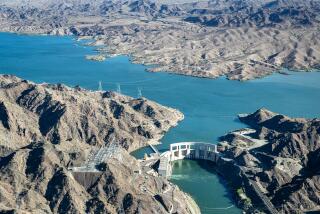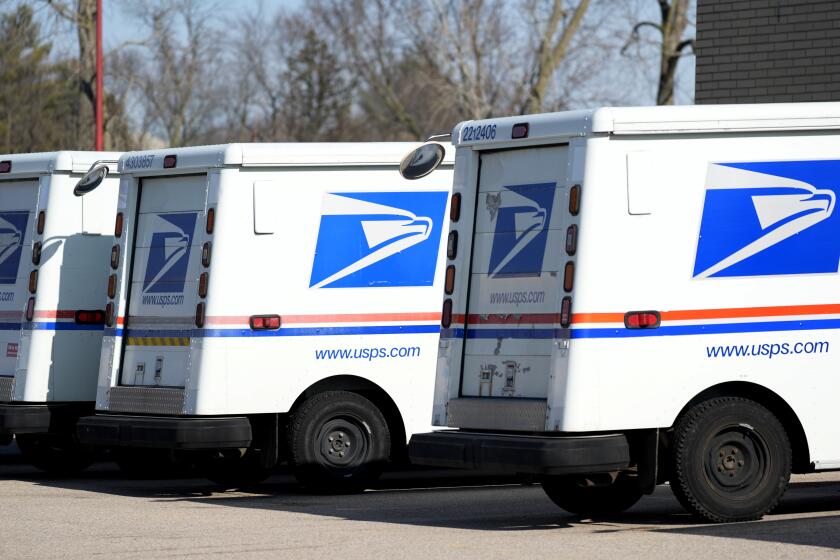Bounty at Lake Powell follows record dry stretch
Reporting from Page, Ariz.
It was another morning of chasing the water at Lake Powell. Jeff Wilson strained to adjust a floating dock to keep up with the swiftly rising level of one of the nation’s biggest reservoirs.
This was supposed to be yet another dry year on the Colorado River system, which feeds Lake Powell and sustains more than 25 million people and upward of 3 million acres of farmland. Some Western states even feared cuts in water deliveries were looming.
Instead, so much snowmelt and storm runoff flowed into the river and its tributaries that for much of the summer Powell rose a foot a day. The reservoir now is 76% full, and its surface has reached the highest point in a decade, dramatically shrinking the white bathtub ring of mineral salts that had ominously marked the lake’s retreat.
Glen Canyon Dam managers are pouring water downriver as fast as they can to Lake Mead, which supplies Arizona, Nevada and Southern California. “We are definitely thrilled to see that,” said Perri Benemelis, a water department manager for Arizona, which along with Nevada, would be first in line for cuts.
This year of surprisingly bountiful snow and rain follows the driest 11-year period in more than a century of record keeping. Ancient tree ring records have shown that droughts can persist for decades in the river basin, punctuated by occasional wet spells. So no one can say if this one is really over or just taking a break. But from Wyoming to California, the seven states that depend on the 1,450-long river are letting out sighs of relief.
A shock of intense blue water set amid the dry red canyon lands of southern Utah, Powell was built to store water for an arid West. But it is also a summer playground that runs, in the words of one local, on “gasoline, sunlight and alcohol.” Power boats and rental houseboats that can cost more than $10,000 a week ferry vacationers up the fingers of the drowned canyon to swim and empty six-packs.
The sudden rush of water into the lake has meant seven-day workweeks for the National Park Service and concessionaire crews that manage the boating facilities. Again and again they have reeled in floating docks and marina utility lines that were extended as the reservoir shrank. Dive teams were called in to move anchors.
At the Hite marina on the lake’s northern end, where boating facilities had been stranded on the dry lake bed for years, workers used a backhoe and trucks to free them from layers of muck and silt as the water rose.
Aramark Parks and Destinations, the concessionaire, moved the Bullfrog marina docks two-thirds of a mile up the bank this year.
“There’s nothing fun about moving boat pumps at 10 in the morning and carrying cables when its 110 degrees,” said Chris Cook, facility manager for the Glen Canyon National Recreation Area. “These guys worked their tails off.”
Cook has been at Powell for 15 years. He watched the lake level plunge roughly 140 feet between the late 1990s, when the reservoir was nearly full, and 2005. The water inched up after that low point, but Cook never thought he’d see it this high again. “It was pretty dismal for a long time in the West; everything was dry.”
Near the Wahweap marina, Cook pointed out boats bobbing in a small inlet. A year ago, he said, that part of the lake was a dirt parking lot. Not far away, a family of French vacationers swam past clumps of tamarisk that followed the shrinking shoreline as the lake fell. Now the shrubs are drowning.
At the Lone Rock campground, the shallow beach area lost some 300 feet to the lake this year, forcing campers to pick up and move their tents and RVs every few days.
Jerry and Linda Haynes have driven about 500 miles from the Los Angeles area to camp with their extended family at Lone Rock almost every summer for 25 years. Even when their traditional beach spots were rimmed in dry, cracked lake bed, they didn’t stay away.
Now that the water is back up, “it’s a double-edged sword,” Jerry Haynes said, sitting in the shade by his RV as a dog napped nearby. “There are fewer camping spots, and there is more competition for beachfront property.”
The number of visitors to the recreation area dropped noticeably over the last decade. But businesses in Page, which owes its existence to the lake, say it’s hard to separate the impact of the drought from the nationwide recession and real estate bust.
The low water levels let hikers into treasured parts of Glen Canyon that had been submerged since Powell began filling in the 1960s. Storms flushed out newly exposed slot canyons that were clogged with sediment accumulated over decades. Now, kayakers are paddling up them.
“We’re constantly opening and closing doors” with the fluctuating water level, said Dave Panu, who guides kayak and boat trips on the reservoir.
The drought lent renewed voice to conservationists who mourn the flooding of Glen Canyon’s stunning landscape and the harm the dam has done to the downriver ecosystem of the Grand Canyon.
Powell’s rebound has not changed their minds. “We still think the system can work with Lake Mead only,” said John Weisheit, conservation director of Living Rivers and Colorado Riverkeeper. Over the long term, he argues, drought and demand in the Colorado basin will eventually empty Powell.
The reservoir level, which peaked July 30, is gradually dropping as releases to Lake Mead outpace flows into Powell.
Mead last year fell to its lowest point since it filled in the 1930s, nearing the elevation that would have triggered delivery cuts in the lower basin under the complex set of laws and regulations that govern the states’ river use. The U.S. Department of Interior had said there was a 10% chance that in 2012 it would declare a shortage on the river for the first time.
Less than half full now, Lake Mead is expected to keep rising for the next year and a half. “We’ve pushed off shortage for years,” said Jeffrey Kightlinger, general manager of the Metropolitan Water District of Southern California, which imports Colorado River supplies.
California has some of the most senior rights on the river, protecting it from early cuts. But the drought eliminated surplus deliveries that the state — and the MWD — long enjoyed. If next year isn’t dry, Kightlinger said, it’s possible that surplus water could be available in 2013.
The drought forced the lower basin states to forge agreements with the federal government. They can now bank water in Lake Mead, whereas before they would lose any portion of their annual allocation they didn’t draw from the reservoir. The MWD plans to bank water this year and next.
Abundant runoff from the Sierra Nevada has also filled California’s reservoirs after a three-year state drought, allowing the agency to put unprecedented amounts of water in reserve. “Pretty amazing turnaround,” Kightlinger said.
This year underscores the Colorado system’s dramatic variability, which could increase with global warming.
The U.S. Bureau of Reclamation recently issued a reportconcluding that climate change will reduce average annual flows on the river by nearly 9% this century. But there will be high-water periods just like this one. Some models have projected occasional years of runoff twice as high as anything ever experienced in the 20th century.
“This is a great year; we needed it,” said Terry Fulp, the bureau’s deputy regional director for the lower Colorado. “It is going to take some pressure off a lot of the system. It doesn’t mean we’re out of the woods.”
More to Read
Start your day right
Sign up for Essential California for news, features and recommendations from the L.A. Times and beyond in your inbox six days a week.
You may occasionally receive promotional content from the Los Angeles Times.







